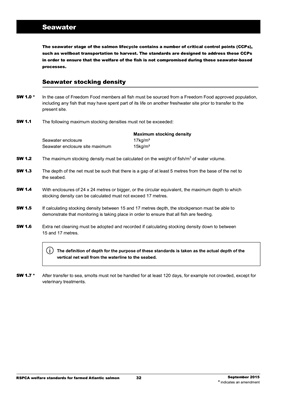
RSPCA welfare standards for farmed Atlantic salmon 32 September 2015
* indicates an amendment
Seawater
The seawater stage of the salmon lifecycle contains a number of critical control points (CCPs),
such as wellboat transportation to harvest. The standards are designed to address these CCPs
in order to ensure that the welfare of the fish is not compromised during these seawater-based
processes.
Seawater stocking density
SW 1.0 * In the case of Freedom Food members all fish must be sourced from a Freedom Food approved population,
including any fish that may have spent part of its life on another freshwater site prior to transfer to the
present site.
SW 1.1 The following maximum stocking densities must not be exceeded:
Maximum stocking density
Seawater enclosure
Seawater enclosure site maximum
17kg/m³
15kg/m³
SW 1.2 The maximum stocking density must be calculated on the weight of fish/m
3 of water volume.
SW 1.3 The depth of the net must be such that there is a gap of at least 5 metres from the base of the net to
the seabed.
SW 1.4 With enclosures of 24 x 24 metres or bigger, or the circular equivalent, the maximum depth to which
stocking density can be calculated must not exceed 17 metres.
SW 1.5 If calculating stocking density between 15 and 17 metres depth, the stockperson must be able to
demonstrate that monitoring is taking place in order to ensure that all fish are feeding.
SW 1.6 Extra net cleaning must be adopted and recorded if calculating stocking density down to between
15 and 17 metres.
The definition of depth for the purpose of these standards is taken as the actual depth of the
vertical net wall from the waterline to the seabed.
SW 1.7 * After transfer to sea, smolts must not be handled for at least 120 days, for example not crowded, except for
veterinary treatments.
i